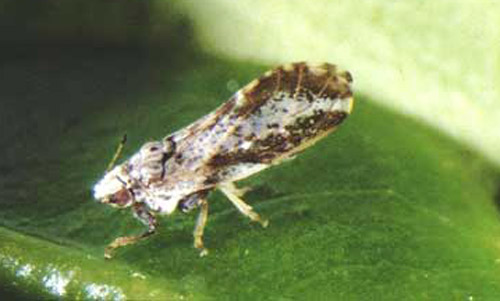
By Robin Koestoyo
FORT PIERCE, Fla. — The Asian citrus psyllid transmits the bacterium associated with the most serious citrus disease worldwide — and now it has a formidable enemy in a fungal pathogen.
The citrus industry at its zenith was spread across about 950,000 Florida acres. Citrus greening reduced it to today’s approximate 400,000 acres. The fungus is Cordyceps javanica, strain Apopka, discovered by research scientist Lance Osborne in the mid-1980s. The fungus was isolated from dead insects on plants in a greenhouse at the University of Florida Mid-Florida Research and Education Center in Apopka, Florida.
Spores of Cordyceps javanica spores grow in bead-like strands across citrus leaves, attaching themselves to the psyllid body, germinating, and infecting the psyllids. It lowers the pest numbers by up to 90%. The fungus sustains itself and its impact on the psyllids for two full weeks after its application. Scientists at two UF Institute of Food and Agricultural Science (UF/IFAS) research centers published their findings in the Sept. 14 issue of Insects, a peer-reviewed science journal.
“Growers must control the psyllid to produce fresh fruit,” said Pasco Avery, a UF/IFAS Indian River Research and Education Center (IRREC) scientist in Fort Pierce. “What the growers need is an integrated pest management program to mitigate the psyllid populations, minimize the input of non-selective insecticides, and preserve the lady beetles, lacewings and parasitic wasps that are the psyllid’s natural enemies.”

The adult Asian citrus psyllid is attracted to volatiles that the citrus trees release while they are in “flush” or when new leaves on branches emerge. Psyllids land on the new citrus flush, and while feeding, insert the citrus greening-associated bacterium into the tree’s phloem.
Avery said the psyllid develops resistance to synthetic broad-spectrum chemical insecticides, and therefore, an integrative pest management program is essential. Scientists can employ a combination of tools such as the fungus C. javanica, along with the psyllid’s natural enemies to protect the trees.
The field experiments took place in 2018 and 2019 at The Florida Research Center for Agricultural Sustainability in Vero Beach, Florida.
“The field study in 2018 indicated that C. javanica alone, C. javanica mixed with white oil, and spinetoram mixed with white oil suppressed the psyllid populations by 60% to 90% and 61% to 83%, seven and 14 days after application,” said Avery.
Avery said only spinetoram plus oil subdued the psyllid 100% up to seven days after the fungus was applied in the 2019 study. Lady beetles that eat Asian citrus psyllids were observed foraging in the citrus trees throughout both studies.
“Fruit growers need to produce healthy fruit free of disease,” Avery said. “The fungus C. javanica is compatible with the environment, the psyllid’s natural enemies, and it suppresses psyllid populations that vector the pathogen associated with the citrus greening disease. We recommend it as part of citrus growers’ integrated pest management strategies.”









